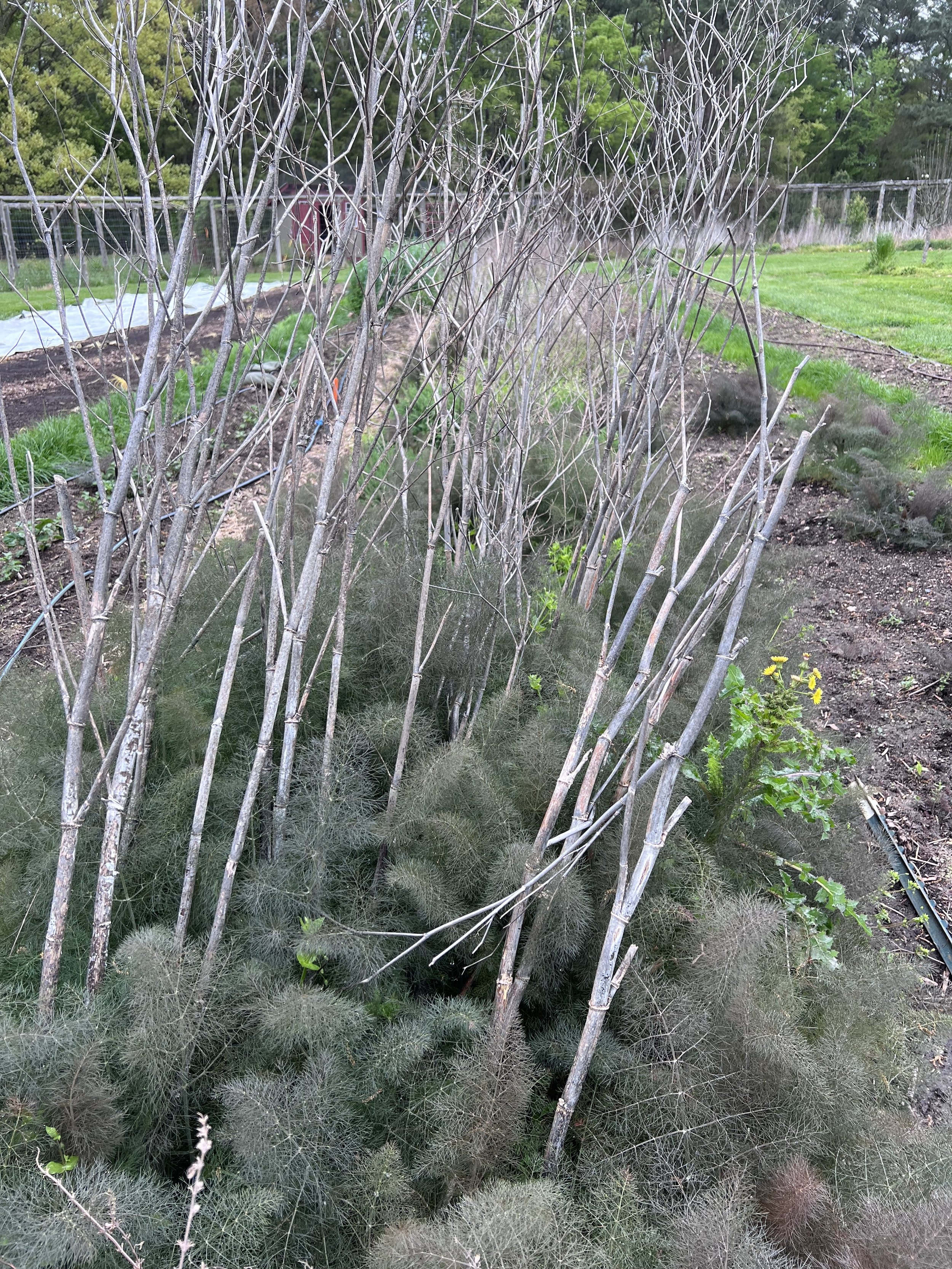With Perennial Rows, Chaos Reigns
On the right, a perennial row. Center and left, row crops of lisianthus and spinach.
Drive through any agricultural region and you’ll see the familiar uniformity of row crops. Sometimes stretching for miles and miles, these machine-manufactured spaces are for sowing and harvesting the same plant in a single file line. It’s for good reason: Spacing out seeds in linear pathways increases the chance of germination and allows enough room for plants to grow strong while still maximizing space. The aisles between rows allow access for maintenance and harvesting (by machine or by human).
On a much smaller scale, we also farm this way. Burkett Farm features five rectangular gardens, each divided into rows set equidistant lengths apart and bounded by aisles. Each row is home to one (or maybe two) specific crops at a time. As any good farmer will assure you, row space is precious. Especially on small farms like ours, every single inch of space is plotted with the maximum number of plants we can fit while still leaving enough room for them to thrive. We use the row cropping method to ensure that we are getting a good yield.
But in this sea of order, one row in each of the beds doesn’t look like the rest - it’s a chaotic hodgepodge of shrubs and twigs and shoots and random blooms. Instead of traditional produce or cut flowers, we’ve planted this rogue row with many different types of perennials, mostly edible herbs. Unlike our annual crops, which we seed and then terminate at the end of the growing cycle, these plants come back every year on their own. Also unlike our annual crops, we don’t bank on these plants as part of our harvesting forecast.
With such limited real estate, it might seem like bad strategy to allot a significant (12%) part of our cultivated garden spaces to these perennials. But perennial rows offer a trifecta of benefits. In the alignment chart of our farm, if annual row crops are “lawful good,” perennial rows would fall under “chaotic good,” and this chaos factors into our larger ecological goals.
We do it for the bugs. The plants in these rows were intentionally selected to attract beneficial bugs to come and stay awhile. It’s our version of a big flashing sign to these desirable tenants:“If you lived here, you’d be home by now.” These species bud up with flowers that provide pollen sources, or they create habitats that pollinators like to live in (or both). If you’re a bug at Burkett Farm, there are many solid choices for habitat– but holing up in a perennial plant instead of an annual plant is like owning versus renting; you don’t have to move every year when pesky farmers come through to clear a field.
In the winter months, we leave the dead branches intact rather than clearing them or trimming them. These hollow stems are particularly attractive residences for native bees, solitary wasps, moths, spiders, and other insects, who burrow or hibernate in cold weather. These perennial rows are so beneficial for pollinators that they’re sometimes referred to as insectary rows.
Pictured: Bronze fennel growing back among dead stalks. We leave the stalks over the winter instead of clearing them to offer habitats for native bees and wasps.
We do it for the soil. Healthy soil loves coverage, and it loves to be left alone. Perennial rows provide both: these plants remain intact (no tilling or clearing), offering a strong coat of armor and plenty of microbial stability to the soil.
Case in point: In a recent round of soil health testing, our pollinator garden - a small bed located on the periphery of our farm that is completely planted with perennials and never sees row crops - scored highest of any of our sites for overall soil health.
We do it for the food. Many of these perennial plants happen to also be edible herbs. Some are quite common, such as rosemary, thyme, and oregano, while others may be less familiar to novice gardeners or cooks. Others that we use in the kitchen include sage, anise hyssop, true hyssop, bronze fennel, and lemon balm. Parsley deserves an honorably mention, though it’s technically a “biennial” and so it needs to be replanted every couple of years. These aromatic herbs are a cook’s best friend and add incredible depths of flavor when cooking.
Our suggestion: Use the softer leaves of oregano, bronze fennel, and anise hyssop in raw applications, like salads or fresh relishes. Woodier sprigs of rosemary and thyme can be overpowering unless you tame their flavor with heat. They also work well when infused in fat (butter or oil, for example) or heated into a syrup.
Some of the biggest proponents of our perennial herb beds? Our chef partners. Cheetie Kumar, chef and owner of Ajja in Raleigh, has a standing weekly order for bronze fennel. Currently, on the Ajja menu you can find it mixed into a green pea chermoula (a North African-inspired condiment) that accompanies lamb seekh, with more on top to garnish.“It’s got such great flavor and does so much more than regular fennel fronds,” she says. One of her favorite pairings: bronze fennel and tomatoes.
Do these reasons create a strong enough argument for farmers to take up planting perennial rows in their beds? It depends what you prioritize. But there’s one more reason to make an economic case for this allocation of row space: perennial plantings create easy opportunities for added-value products. Herbs take well to multiple forms of preservation and lend themselves to added value shelf-stable products, from dried spice blends to salves and extracts.
So next time you come across a perfectly uniform row of crops at a farm, start asking the question: how about adding a little chaos?
Our perennial plant index:
Goldenrod
Bronze fennel
Winter thyme
Hyssop
Anise hyssop
Sage
Rosemary
Common yarrow
Joe Pye weed
Common milkweed
Echinacea
Baptisia
Lemon balm
Verbena
Lavender


